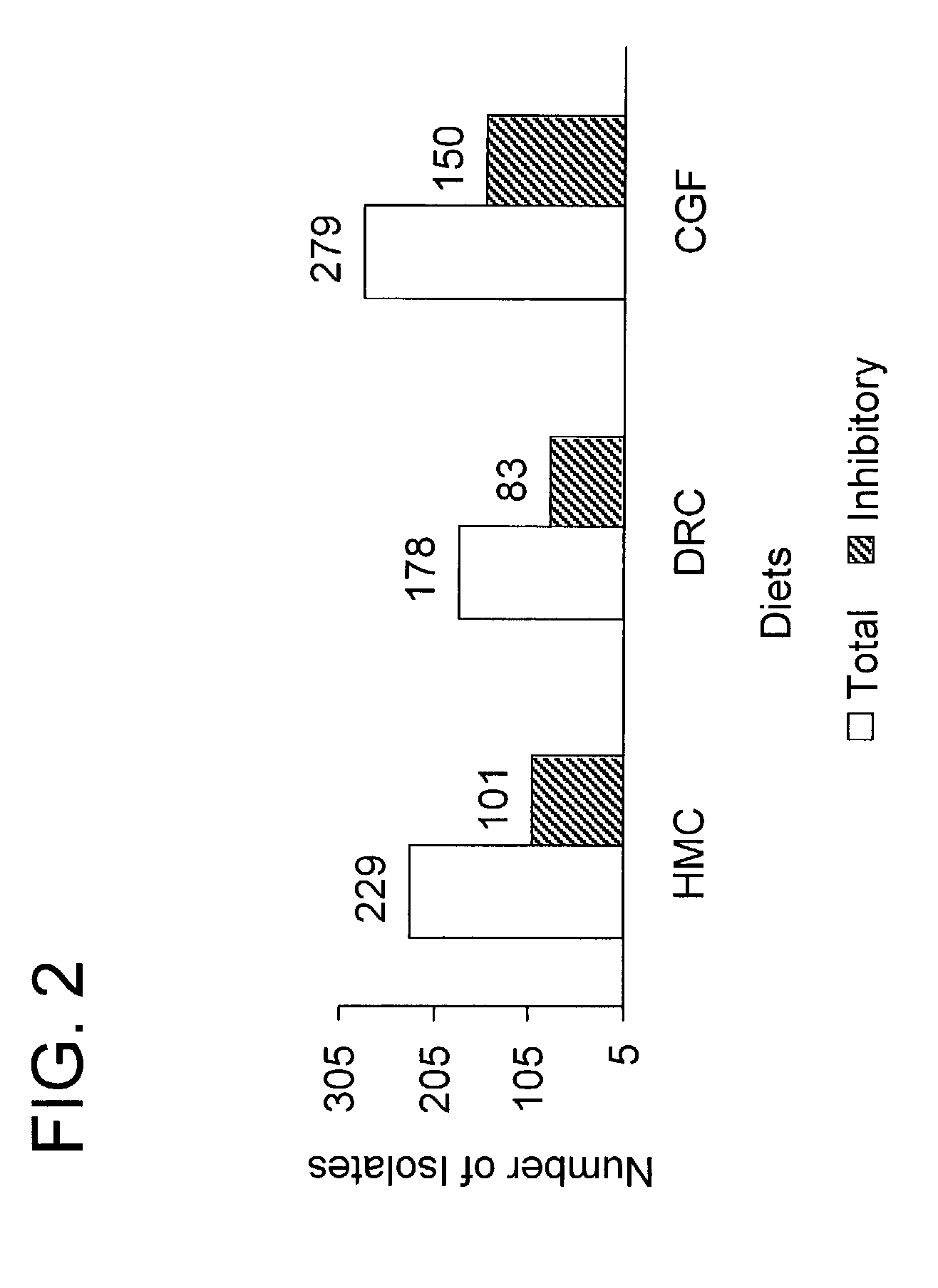Lactic acid bacteria cultures that inhibit food-borne pathogens
a technology of lactic acid bacteria and food-borne pathogens, which is applied in the field of probiotic lactic acid bacteria, can solve the problems of livestock industry treatment costs, livestock deaths, and economic burden of these agents, and achieve the effect of increasing feed efficiency in a mature ruminan
- Summary
- Abstract
- Description
- Claims
- Application Information
AI Technical Summary
Benefits of technology
Problems solved by technology
Method used
Image
Examples
example 1
Isolation of Strains of LAB From Healthy Cattle
[0059]Cattle that were fecal culture negative for E. coli O157:H7 were selected to supply fecal samples for isolation of LAB that were to be screened for inhibitory activity towards E. coli O157:H7. Manure sample from the Animal Science Department of University of Nebraska-Lincoln (UNL) were obtained at three-week intervals over a period of twelve weeks (4 sampling periods) from cattle that were fed three different finishing diets, (1) High Moisture Corn (HMC), (2) Dry Rolled Corn (DRC), and (3) Corn Gluten Feed (CGF) (Table 1). Samples were collected separately from 5-7 cows from each diet group and numbered as illustrated in FIG. 1.
[0060]One gram of each fecal sample was added to 10 ml of sterile de Man-Rogosa-Sharpe (MRS) broth (Difco Becton Dickinson Microbiology Systems, Sparks, Md.) and mixed thoroughly by shaking. The fecal material was then plated on Lactobacillus Selection (LBS) agar (BBL Becton Dickinson Microbiology Systems, ...
example 2
Screening Isolated Colonies for Inhibition Towards E. coli O157:H7
[0063]Isolated strains were initially screened for inhibition towards E. coli O157:H7 using the agar spot test. An overnight culture of each cattle isolate to be tested was prepared by inoculating stock culture in 10 ml of MRS broth. Cultures of individual strains were then spot-inoculated onto the surface of MRS agar plates and incubated for 24-48 hours at 37° C. in plastic bags flushed with C02 for 30 seconds. A four-strain mixture of E. coli O157:H7 was used to screen the isolates for inhibitory activity towards E. coli O157:H7. The E. coli strains used in the study were originally obtained from the laboratory of Charles Kaspar (Food Research Institute, University of Wisconsin, Madison, Wis.) and included strains 920, 922, 944, and 966 (all cattle isolates). Overnight cultures of E. coli strains were prepared (5×108 CFU / ml) by inoculating 10 ml of tryptic soy broth (TSB) (Difco Becton Dickinson Microbiology Systems...
example 3
Test for Bile Tolerance
[0066]The isolates that were most inhibitory towards E. coli O157:H7 in the agar spot test were selected for bile tolerance tests. The method used for testing bile tolerance was similar to the one described by Gilliland et al. (Gilliland, S. E., Stanley, T. E., and Bush, L. J. 1984. Importance of bile tolerance of Lactobacillus acidophilus used as a dietary adjunct. J. Dairy Sci. 67: 3045-3051). An overnight culture of the selected isolates was prepared in 10 ml MRS broth and 0.1 ml of the culture suspension was inoculated into tubes containing 10 ml MRS broth with 0.5, 0.15, 0.3% oxgall or without oxgall (control). The inoculated tubes were incubated at 37° C. in a water bath. Growth of the organisms was monitored at 0, 2, 4, 6, and 24 hours by measuring absorbance at 660 nm. The test for each strain was repeated three times.
[0067]Bile tolerance studies indicated that all isolates except A22 showed increased growth rate under all bile conditions (0. 0.5, 0.15...
PUM
 Login to View More
Login to View More Abstract
Description
Claims
Application Information
 Login to View More
Login to View More - R&D
- Intellectual Property
- Life Sciences
- Materials
- Tech Scout
- Unparalleled Data Quality
- Higher Quality Content
- 60% Fewer Hallucinations
Browse by: Latest US Patents, China's latest patents, Technical Efficacy Thesaurus, Application Domain, Technology Topic, Popular Technical Reports.
© 2025 PatSnap. All rights reserved.Legal|Privacy policy|Modern Slavery Act Transparency Statement|Sitemap|About US| Contact US: help@patsnap.com



